Best slow feeder cat bowls for happy, healthy pets in 2025
The best slow feeder cat bowls help banish tummy troubles, prevent your kitty from gobbling, and add entertainment to mealtimes. We share our top picks below.
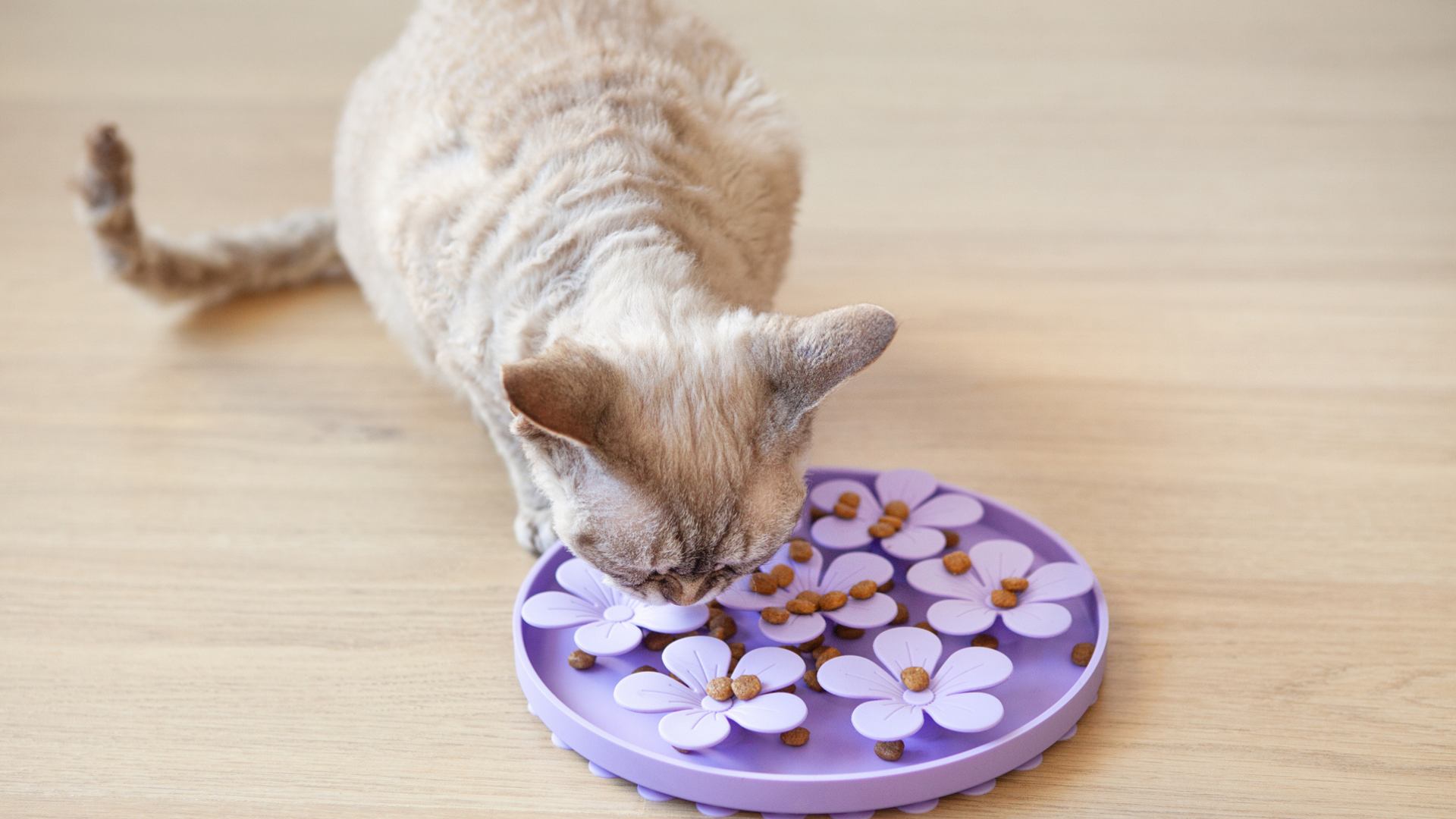
The best slow feeder cat bowls can help stop your cat from eating too fast and getting sick, and they can help cats maintain weight better, too.
Slow feeder bowls decrease how quickly your feline friend eats so they feel full faster. As cat behaviorist Marjan Debevere, DVM, explains, “When a cat eats slower, it allows the brain to register that it’s full earlier than if it was eating out of a normal bowl, therefore eating less.”
Like the best cat puzzle feeders, slow feeder bowls also add mental stimulation to mealtimes. Cats hunt for their food in the wild, and using a slow feeder is more like hunting than eating out of a regular bowl. These feeders help prevent boredom, too — another reason cats might devour their meals.
Dr. Georgina Ushi, DVM, also emphasizes the importance of mixing up your slow feeder options to keep cats engaged: “Pet owners should look for slow feeder bowls with varying shapes and obstacles to challenge their cat’s natural hunting instincts and make mealtimes more enjoyable.”
Slow feeder bowls work with both the best dry cat foods and best wet cat foods, and you have plenty of choices for bowls that will fit your cat’s preferences. Check out our recommendations below and help your cat develop healthy eating habits and enjoy happier mealtimes.
The best slow feeder cat bowls 2025
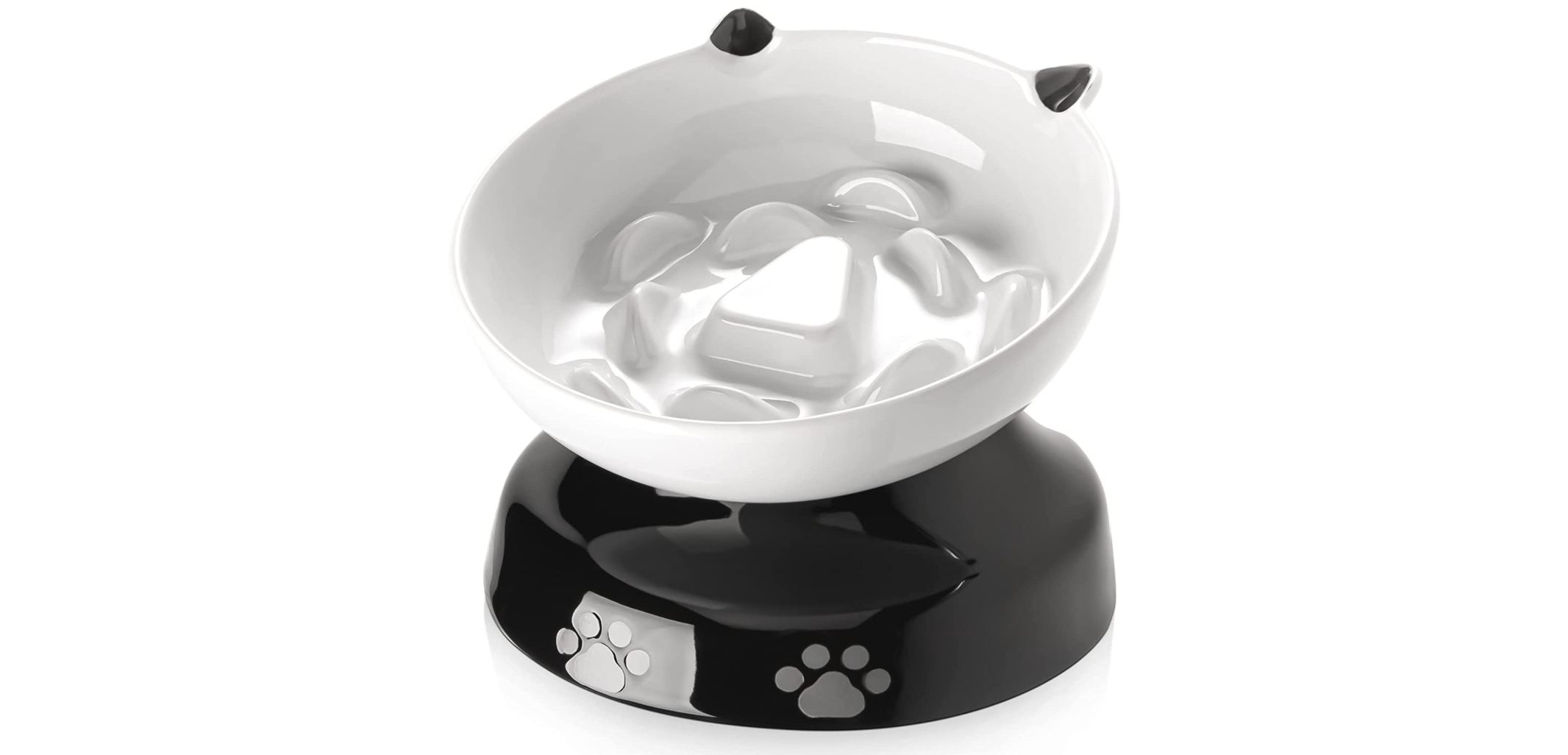
Best overall slow feeder cat bowl
A high-quality and affordable slow-feeder bowl, the Y YHY Cat Slow Feeder takes out our top spot in this guide thanks to the clever raised and slanted design that improves digestion and reduces vomiting.
We love that this bowl creates a more natural eating position, allowing the spine to stay in alignment and the food to travel more easily from the mouth down into the digestive system. It also reduces neck burden, making it ideal for cats who suffer from arthritis or other mobility issues.
Awarded 4.6 out of five stars on Amazon, pet owners highly recommend this bowl when it comes to helping their cats to keep their food down. People love that the mouth of the bowl is nice and wide, the maze is not too deep and it’s easy to clean. However, buyers do state that the bowl breaks easily if dropped.
Reasons to buy: If you have a cat prone to vomiting.
Reasons to avoid: Fragile.
Pros
- 32-inch height gives a great stretch
- Sturdy and durable
- Easy to assemble
Cons
- Expensive

Best budget slow feeder cat bowl
This is a slow feeder with a difference. Rather than a bowl, this fish-shaped mat with ribs and ridges helps to enrich – and slow – the feeding experience, and relieving boredom and anxiety at the same time.
Neatly named Casper and Felix, you have the choice of two mat designs and the option of three colors – green, orange or turquoise. Both mat designs have a low profile and provide an intricate selection of small and larger sections where you can add your cat’s favorite food. Casper is the more complicated of the two and provides more of a challenge, which makes it ideal for adult cats.
Cat owners are impressed with how lightweight this slow feeder is while still being sturdy and that it provides a good level of challenge. With 4.3 stars on Amazon, the one frequently cited drawback is how tricky it is to clean.
Reasons to buy: Good for slow feeding wet food.
Reasons to avoid: Difficult to clean.
Pros
- 32-inch height gives a great stretch
- Sturdy and durable
- Easy to assemble
Cons
- Expensive
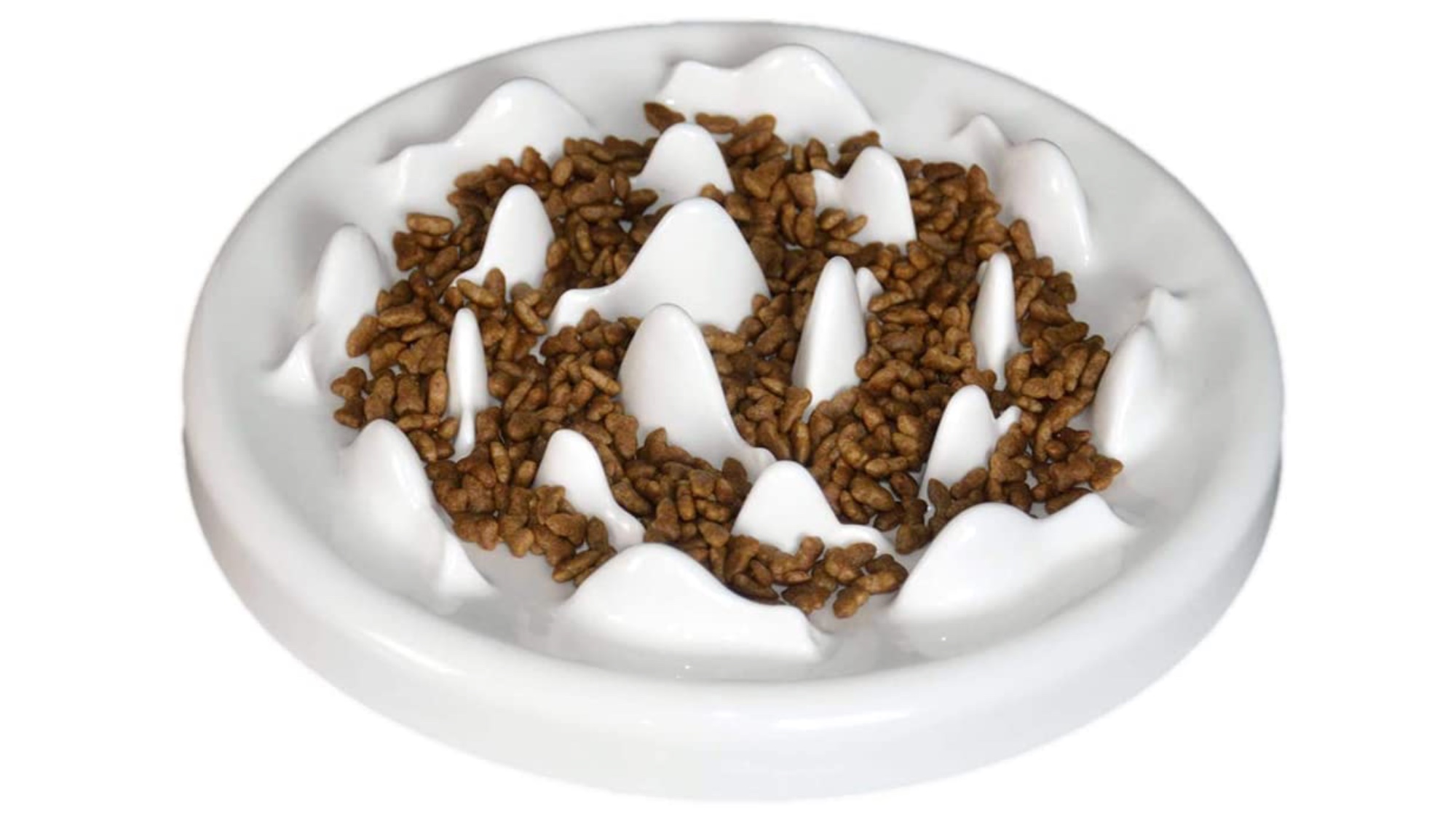
Best ceramic slow feeder cat bowl
Not a fan of plastic? Want a longer-lasting heavy-duty ceramic finish just like the bowls you have in your cupboard? Then this simple slow feeder could just be the design for you.
Made from high-quality, non-toxic, lead, and cadmium-free ceramic material the bowl is pet-friendly and odor-free, meaning the only smell you will get from the bowl is whatever cat food you put in it. And when you do have to wash it you can stick it in the dishwasher without worrying about ruining the bowl.
Pet owners feel that this bowl works well for their cats when it comes to slowing down their eating and comment on how heavy-duty and durable it is. With 4.3 stars on Amazon, the one thing people aren’t so keen on is how big it is, with many feeling it’s far too large for cats.
Reasons to buy: Challenging design.
Reasons to avoid: May be unsuitable for smaller cats.
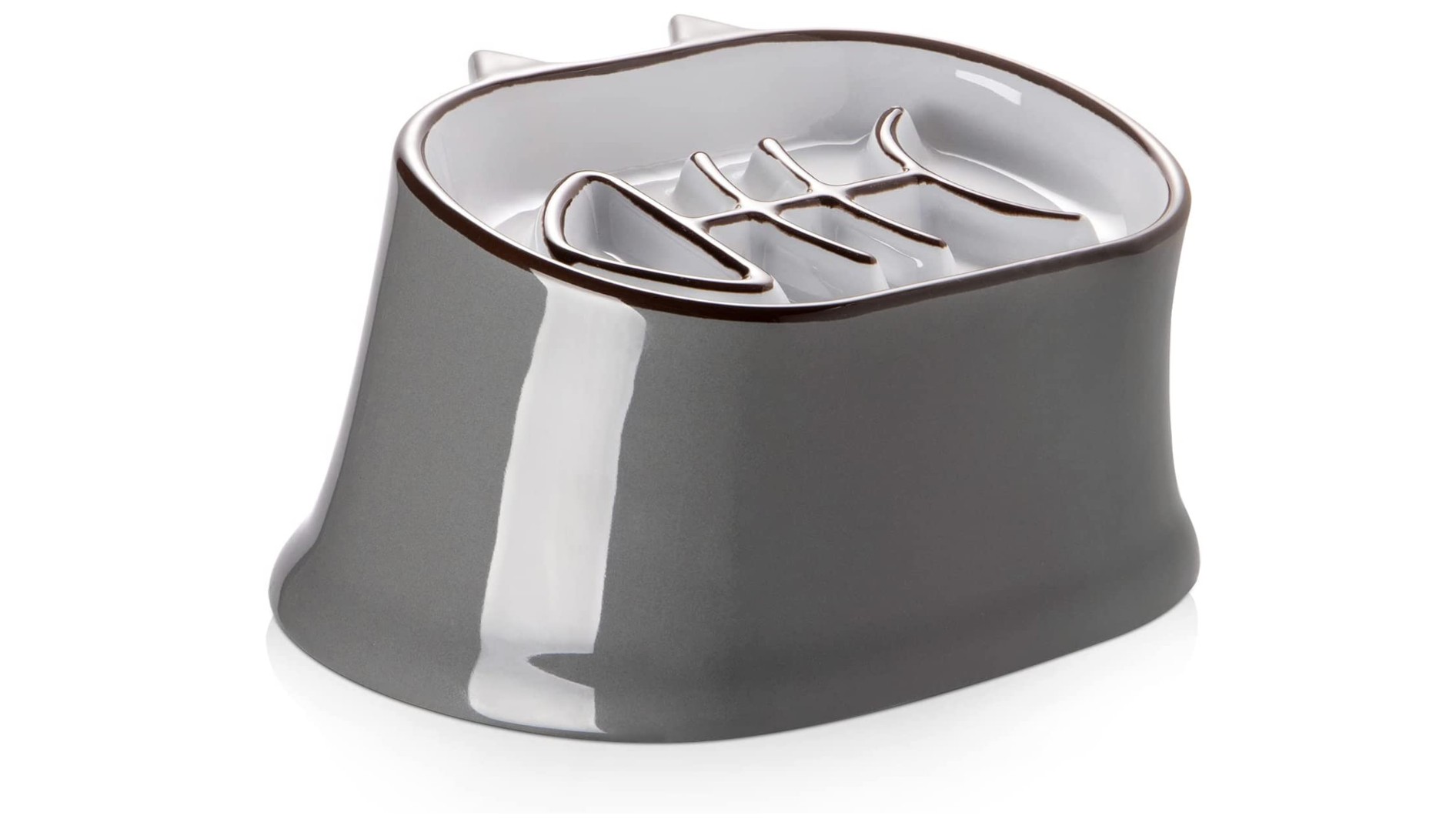
Best anti-vomit slow feeder cat bowl
Is it a slow feeder? Is it an anti-vomit bowl? Well, actually, it's both! We're loving this tilted and elevated cat food bowl with its generous 4.4in height that works to beautifully align the neck and spine to create a more comfortable and natural feeding position.
The stylish and sturdy ceramic design features a fish bone down the middle which traps wet and dry food in a variety of places to prolong your moggy's meal time, prevent bloat and reduce the burden of food passing into the stomach.
Giving this product 4.4 stars on Amazon, buyers find that the grooves on this bowl are just right for holding both wet and dry food. They also note how sturdy, big and stable the bowl is, although some do note that they wish it were deeper.
Reason to buy: Raised design prevents spillages.
Reason to avoid: Shallow design may not hold sufficient food.
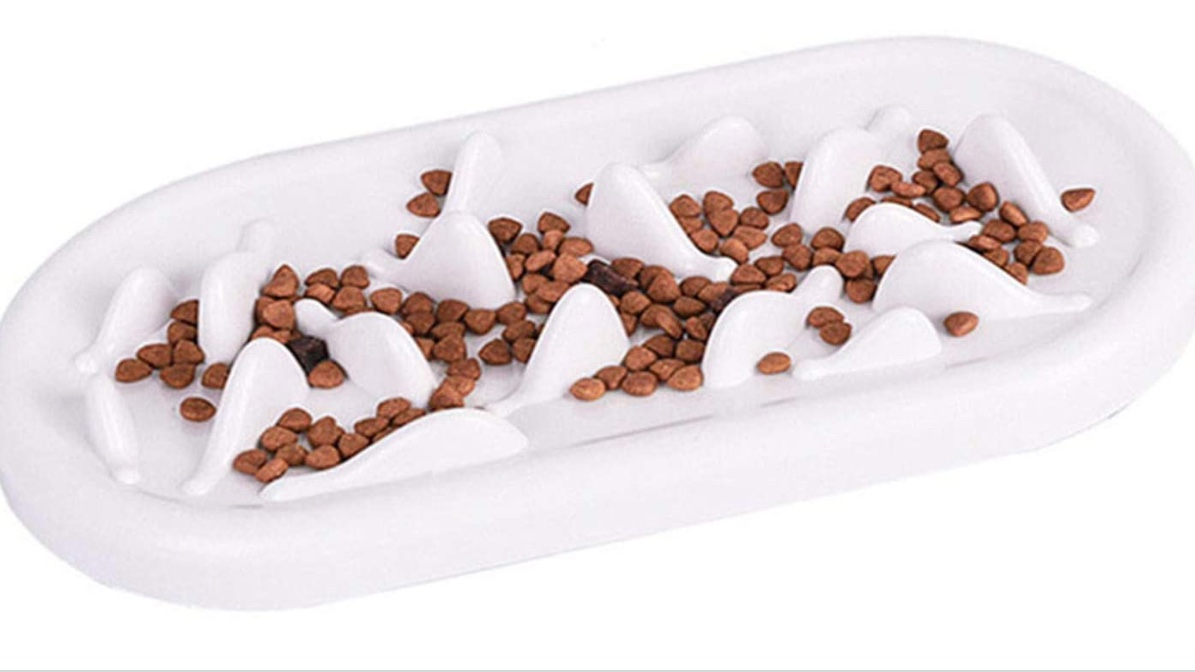
Best for cats who share
Cat bowls are round, aren’t they? Well, this one isn’t. This slow feeder cat bowl takes a slight detour from the standard circular bowl design and offers a rectangular style design. This gives more surface to spread your fur friends’ favorite food and ultimately stop them gulping down their dinner far too quickly.
Measuring 11.8 inches in length, 5.9 inches in width, and 1.7 inches in height it is perfectly sized to allow two cats to feed at the bowl at the same time. There are four anti-skid pads on the bottom of the bowl to prevent it from slipping away while your cat is trying to get their paws and jaws on its tasty treats.
With 4.3 stars on Amazon, many pet parents find this bowl highly efficient in preventing both quick eating and vomiting after meals. People love that it can go in the dishwasher for easy cleaning, but some would prefer a bigger rim to prevent kibble from ending up on the floor.
Reasons to buy: Suitable for multi-cat households.
Reasons to avoid: Low rim may cause spillage.
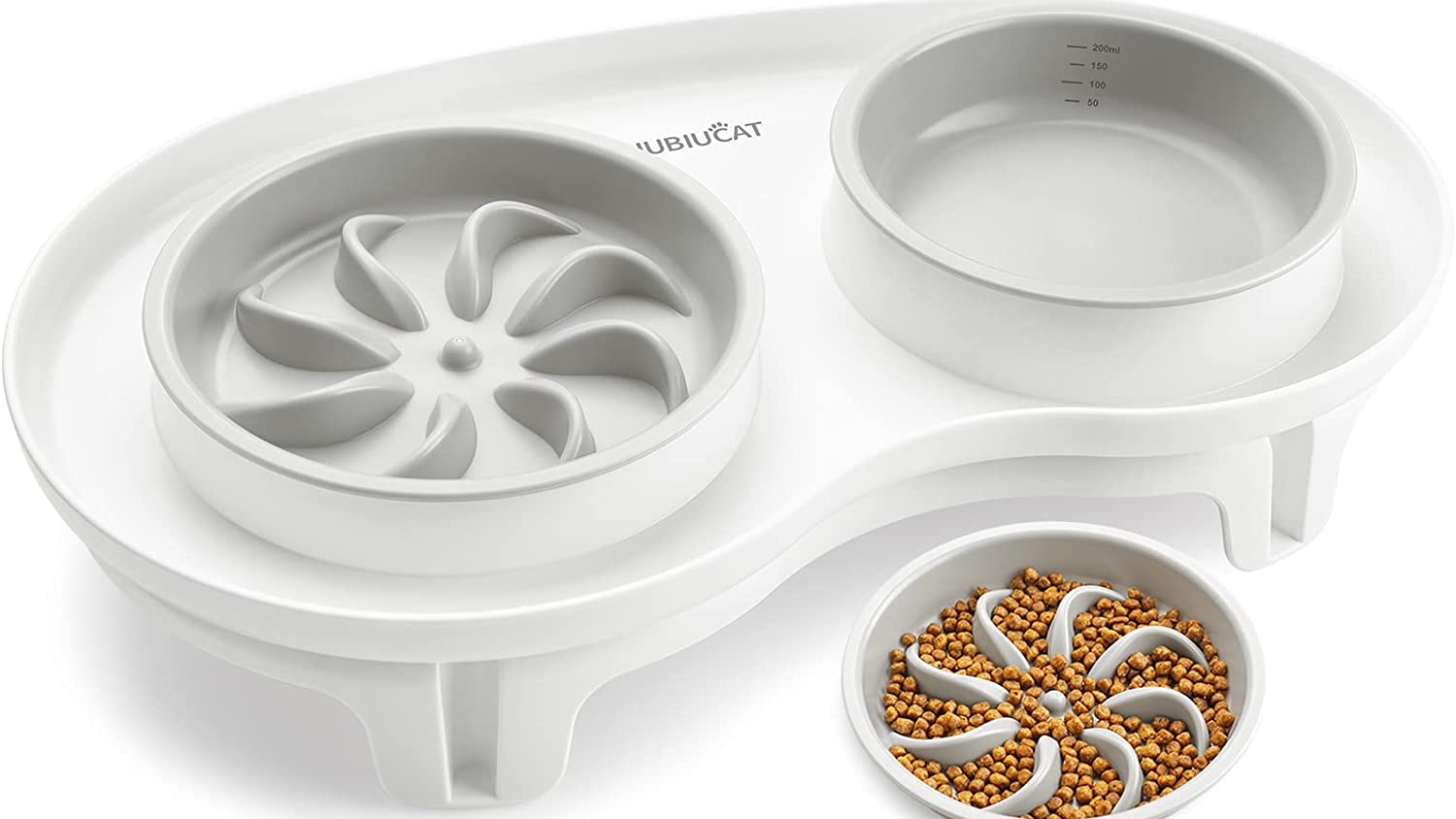
Best for low mess
If you're looking for a slow feeder cat bowl that ticks multiple boxes, you shouldn't look much further than this. As well as providing a bowl with a reasonably complicated pattern, it comes on a set of legs that raises the feeder to a more comfortable, natural level for your cat.
This puts less strain on your cat's neck, which is particularly important if they're going to be taking as long as 20 minutes to eat, as the manufacturer suggests. By placing your pet in a more relaxing position, it should also result in less mess – although a useful tray surrounding the bowl is sure to catch most of the drops in a sign that the maker has really thought this product through.
Praising the sturdiness, catch tray and quality, buyers have awarded this product 4.3 stars and have noted a great deal of improvement in their cats’ eating habits since using it. However, some say they’d like the ridges to be higher.
Reasons to buy: You’re looking to be hassle free – it comes with six bowls and catches spills.
Reasons to avoid: Water bowl smaller than we'd like.
Pros
- Great value for money
- Hours of amusement
- Easy to assemble
Cons
- Balls may come loose from their track
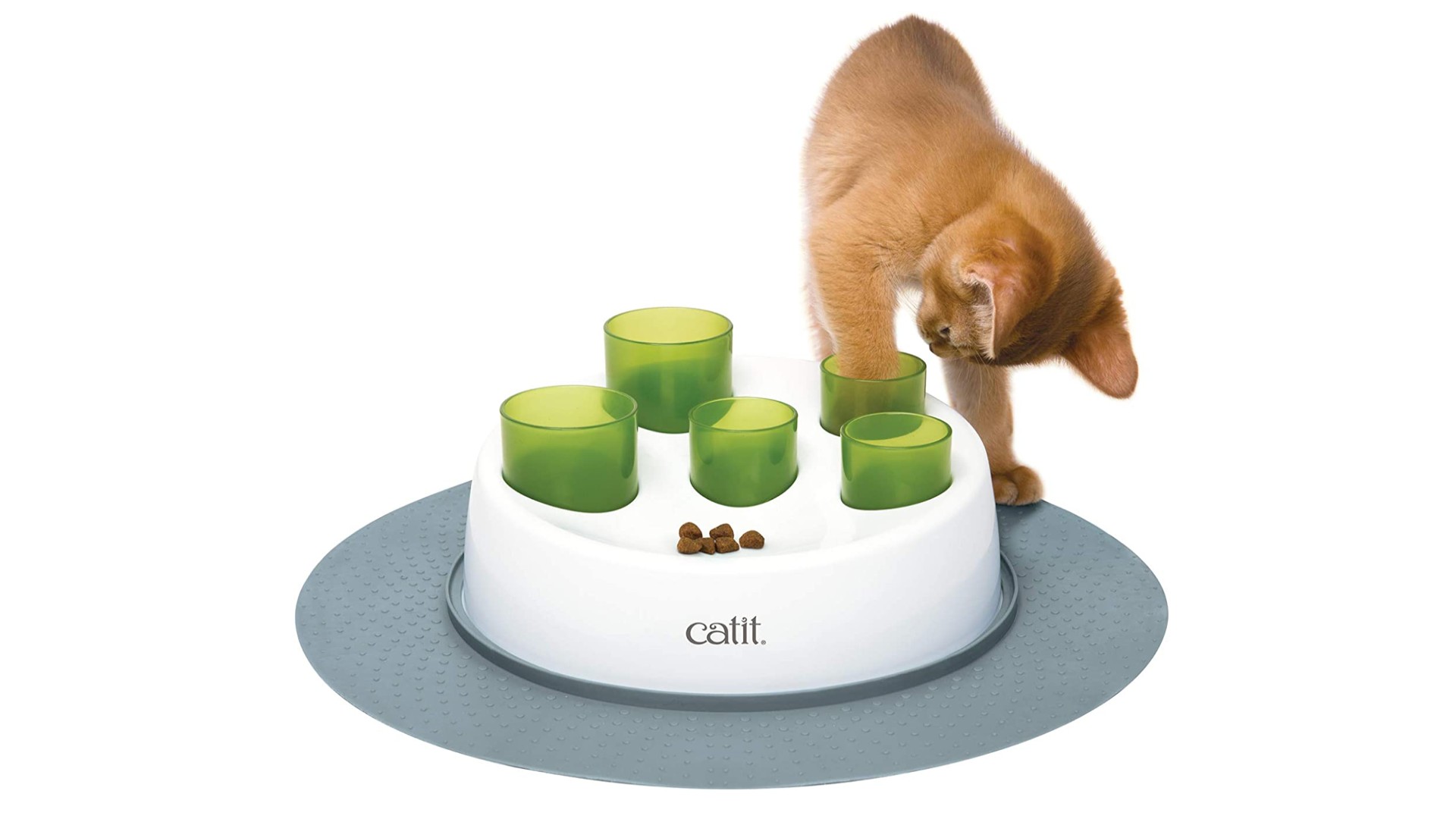
Best interactive slow feeder cat bowl
Slow your feline friends eating and keep them entertained at the same time with this brilliant interactive feeder from Catit. Featuring multiple tubes that stimulate natural pawing behavior, your kitty will be kept entertained for ages as they work to gain access to the dry kibble and treats hidden in the tubes.
The tubes come in two different shapes to vary the degree of difficulty, so it's ideal if you're looking for a way to challenge your beloved bundle of fluff and give them a good mental workout.
Cat owners love that this product is both a great way to slow their fur friends eating down and a fun game that keeps them amused. Buyers like that it helps their cats to burn off energy and challenge their brains, but they do wish the green cups were attached to prevent their cats from tipping them over - hence the 4.3 star rating on Amazon.
Reason to buy: Easy to disassemble and clean, and encourages natural behavior.
Reason to avoid: Green cups are not attached, but this does make them easier to clean.
How to choose the best slow feeder cat bowl
What makes a great slow feeder cat bowl depends very much on your cat, but the size is definitely important. If you have a small cat or a kitten, you don’t need a bowl that is five times the size of its head and easy to eat from. This will do little to help with slowing down how fast your feline friend eats. A five-inch bowl is good for kittens and small cats. Try something bigger for larger cats.
Then you need to think about the shape. Most bowls are circular and have edges which can mean your cat’s whiskers will get in the way when eating. If this bothers your cat then you want to think about getting a flatter style bowl. But this then brings the issue of spillage. So you will need to choose what works best for you and your cat.
The pattern inside the bowl is important. If you need a simple slow feeder then choose something with a few ridges on the bowl. Also, consider the height of the ridges. Too high and it will be difficult for your cat to eat and they may lose interest in their food.
If you want more of a challenge choose a puzzle feeder to add interactivity and interest to mealtimes. Finally, choose something easy to clean, and if you have a dishwasher consider one that is dishwasher safe.
How we selected the best slow feeder cat bowls
Size: We made sure to avoid very deep bowls that your cat would struggle to get their food out of and instead opted for wider and shallower options to prevent whisker fatigue and promote a more enjoyable eating experience.
Style: To give you the widest variety of choice, we tried to include a range of slow feeder bowls including mats, puzzles, and elevated options. We also took into account the shape, choosing models with a higher rim where possible to prevent spillage and mess.
Material: Black chin is a common problem amongst cats who eat from plastic bowls as these can become scratched, allowing bacteria to form. Many slow feeders are made from plastic and these are often the more affordable option, so we’ve included these in our guide for those on a budget. However, we’ve also selected a range of more hygienic feeders made from ceramic and silicone.
Are slow feeders good for cats?
While a lot of pet parents choose to invest in a slow feeder cat bowl to reduce the risk that their feline friend will experience digestive disturbances, Debevere points out that this isn’t the only benefit that a slow feeder bowl can offer.
“Slow feeders can also provide mental stimulation, especially if a challenging puzzle feeder is chosen,” she says. “Depending on the design, there are different levels of difficulty to obtain the food. A cat whose brain is encouraged to problem-solve will be much less bored and will keep his mind sharp. A bored cat can very quickly become a frustrated and destructive cat. Providing them with a puzzle feeder will go some way toward the mental and emotional well-being of your cat. Slow feeders offer the opportunity for your cat to act on their hard-wired instincts to hunt and to fulfill their most essential survival instinct.”
Debevere says that not all slow feeder bowls are designed for cats, so it’s important to check the label carefully to ensure you aren’t getting one that’s meant for a dog. She also explains that how you introduce your cat to their new bowl is crucial, as is considering the age and stage of your feline friend.
“As cats are creatures of routine and predictability, a change of bowl can cause stress so consider making the change really gradually. Cats who have a history of not eating consistently are most likely not in need of a slow feeder and are best left to eat their main meals from the bowl they know and love. Slow feeders are not suitable for elderly cats with mobility and dexterity issues, picky eaters, and diabetic cats.”
Do slow feeder bowls work?
“Slow feeders are bowls or puzzles designed to keep pets from eating too quickly or too much which can lead to indigestion and vomiting,” Debevere explains. “Frequent vomiting is never a normal behavior and requires veterinary attention. The purpose of slow feeders is to reduce the amount of food taken in within one sitting so it’s important not to overfill the feeder. Slower eating reduces bloating and aids digestion and nutrient absorption. Therefore reducing the risk of vomiting.
Another way to reduce vomiting is by using an anti-vomit cat bowl which is specifically designed to reduce vomiting. It is tilted and elevated in a way that prevents vomiting. It’s designed to stop the cat from taking in too much air whilst eating and thus cut down on vomiting. Anti-vomit cat bowls can also be used as water dishes and can be especially useful with flat-faced breeds and senior arthritic cats or those wearing a “cone of shame”.
An anti-vomit bowl is easy on the cat’s digestive system and promotes a healthy posture during mealtime, reducing neck strain and “whisker fatigue", a stressful condition that arises from too much friction between the whiskers and the high side of a food bowl.”
Are there any downsides to using a cat slow feeder?
Cats are not just finicky about their dietary choices; they can also be very particular about what they’re eating out of. So, a potential downside to using a cat slow feeder is that you may need to try several options until you find one your kitty likes. This can take time and patience. Introduce a slow feeder slowly, and start by putting some of the best cat treats inside to make it extra appealing.
Another downside is the potential for your furry family member to damage their bowl while eating. Vet tech Shannon Nowak, BS, LVT, RVT advises that pets “should always be supervised while using the food toy to prevent destruction.”

Kathryn is a freelance writer who has been a member of the PetsRadar family since it launched in 2020. Highly experienced in her field, she's driven by a desire to provide pet parents with accurate, timely, and informative content that enables them to provide their fur friends with everything they need to thrive. Kathryn works closely with vets and trainers to ensure all articles offer the most up-to-date information across a range of pet-related fields, from insights into health and behavior issues to tips on products and training. When she’s not busy crafting the perfect sentence for her features, buying guides and news pieces, she can be found hanging out with her family (which includes one super sassy cat), drinking copious amounts of Jasmine tea and reading all the books.
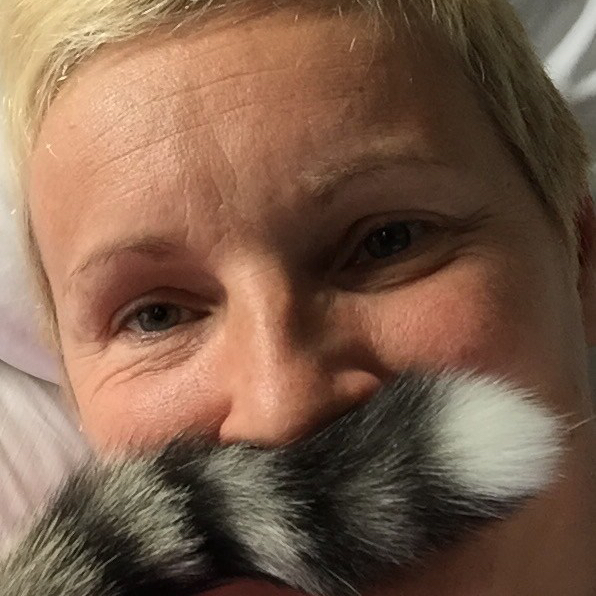
Marjan is a qualified (ADip FBM), certified, vet-referred cat behaviorist based in North London. She studied Feline Behaviour & Psychology at Compass Education and qualified with a distinction in December 2019. She specializes in feline behavior as cats are her passion and the species she is most in tune with. You can follow her on Instagram at lillmanlulu_luigi_and_co

A 2009 graduate of the University of Florida College of Veterinary Medicine, Dr. Georgina Ushi works in the Tampa Bay area, providing compassionate care to dogs and cats. Alongside her clinical work, she consults for pet well-being brands and writes for her blog, Pet Health Love. Dr. Ushi is passionate about sharing her knowledge to educate and inspire pet owners, and her professional interests include emergency and critical care, wildlife medicine, nutrition, and hospice and palliative care.
Get the best advice, tips and top tech for your beloved Pets

Kathryn is a freelance writer who has been a member of the PetsRadar family since it launched in 2020. Highly experienced in her field, she's driven by a desire to provide pet parents with accurate, timely, and informative content that enables them to provide their fur friends with everything they need to thrive.
Kathryn works closely with vets and trainers to ensure all articles offer the most up-to-date information across a range of pet-related fields, from insights into health and behavior issues to tips on products and training.
When she’s not busy crafting the perfect sentence for her features, buying guides and news pieces, she can be found hanging out with her family (which includes one super sassy cat and a kitten), drinking copious amounts of Jasmine tea and reading all the books.
She has written for a range of publications, including Fit&Well, Top Ten Reviews, LiveScience, Goodto, and Product Hunt.
- Steve Jenkins
- Liz FinchAnimal welfare expert
